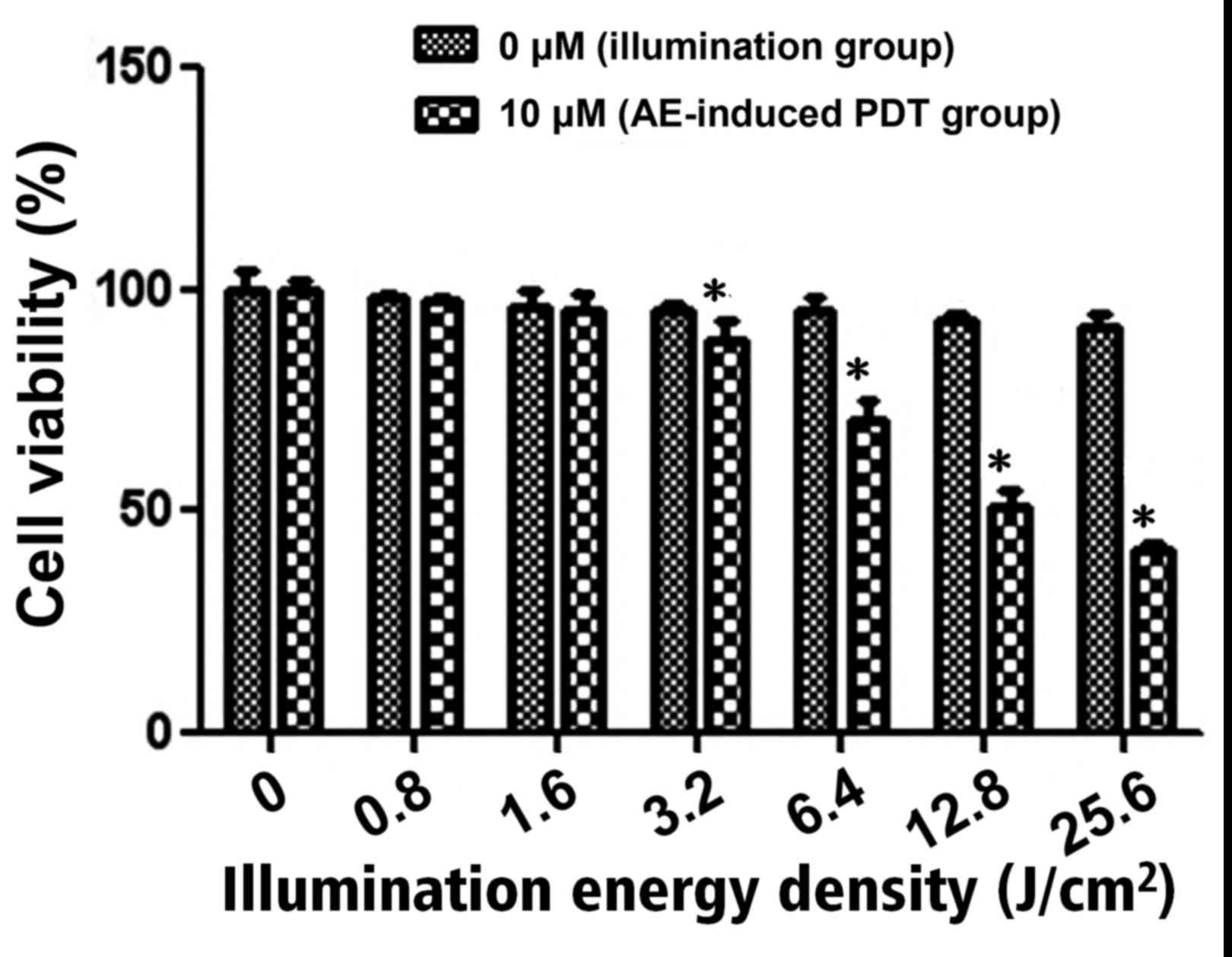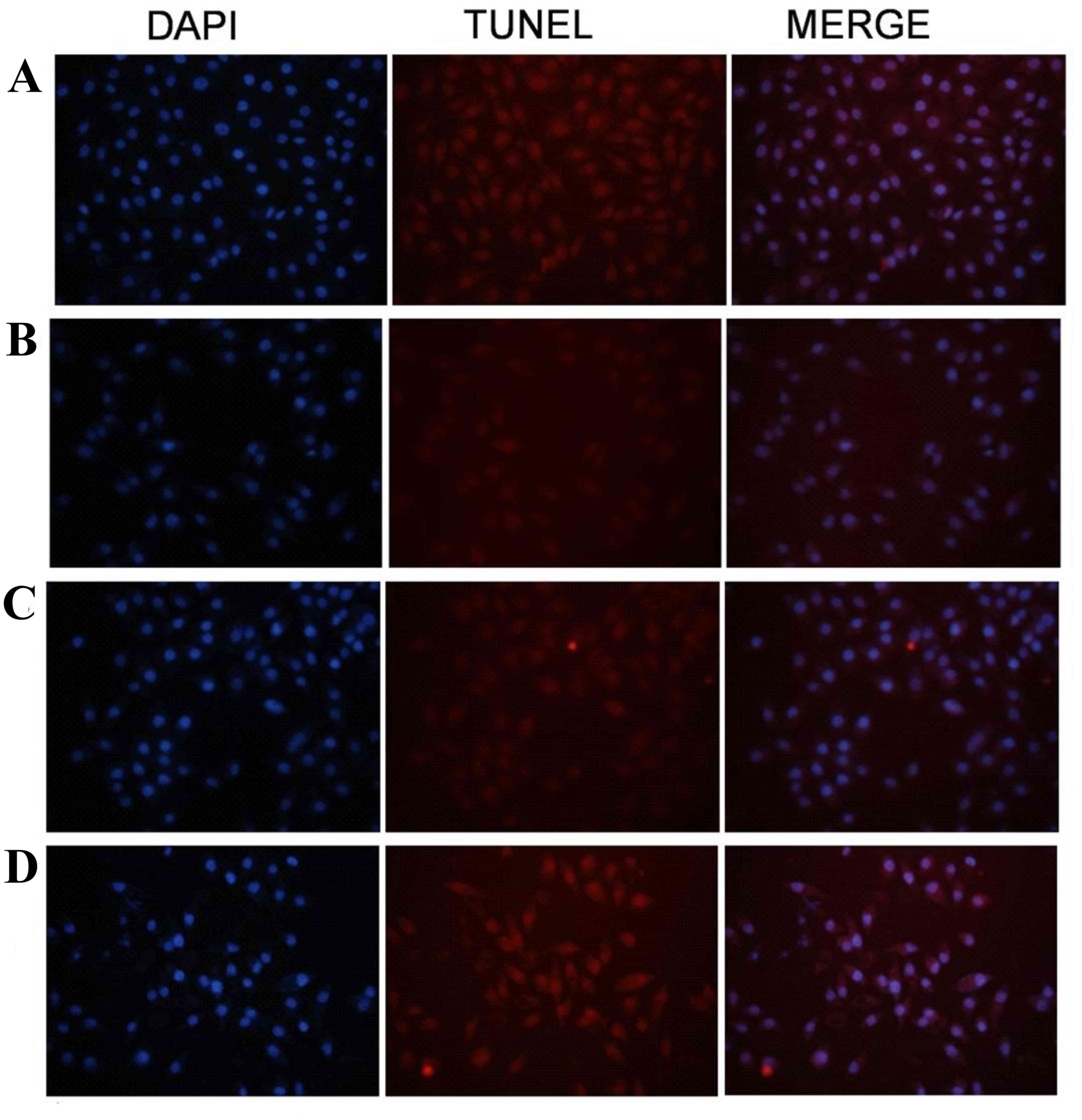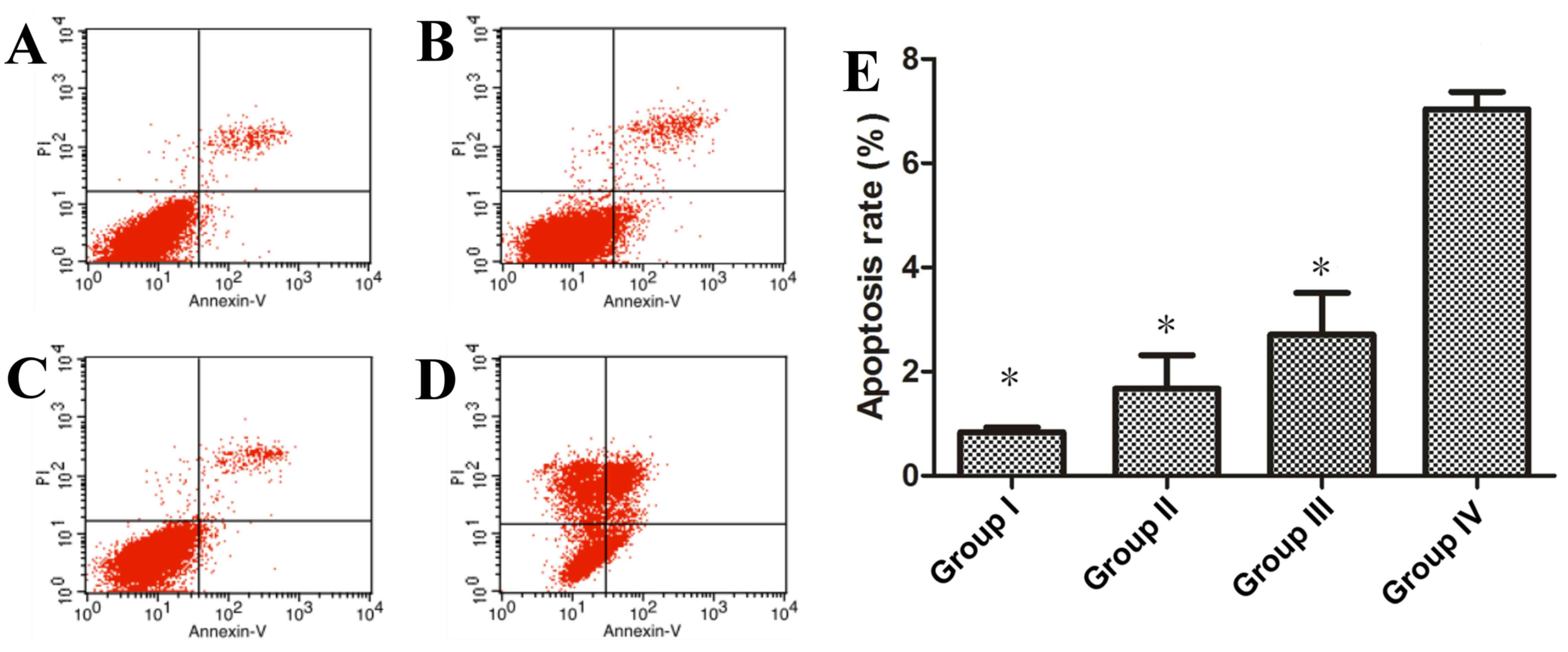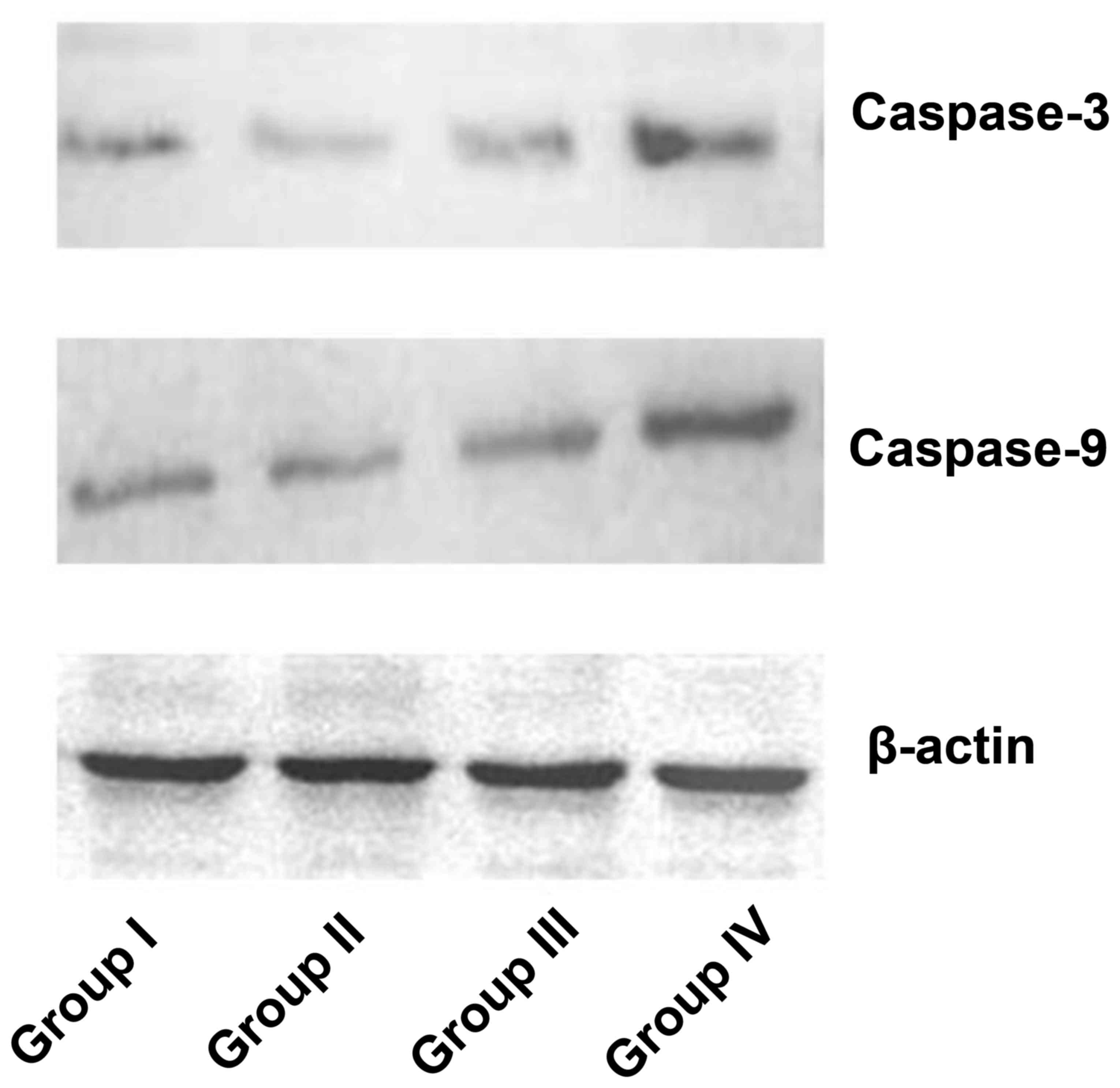The effect of aloe‑emodin‑induced photodynamic activity on the apoptosis of human gastric cancer cells: A pilot study
- Authors:
- Published online on: March 27, 2017 https://doi.org/10.3892/ol.2017.5915
- Pages: 3431-3436
-
Copyright: © Lin et al. This is an open access article distributed under the terms of Creative Commons Attribution License.
Abstract
Introduction
Photodynamic therapy (PDT) is a photochemical modality, which has been suggested to be a potential novel treatment for various types of cancer, including esophageal cancer, glioblastoma and breast cancer (1–3). In the PDT process, the photosensitizer (PS) serves a critical function. It selectively concentrates at the tumor tissue and is activated by light irradiation of an appropriate wavelength. This is followed by the generation of reactive oxygen species (ROS), which result in in cellular destruction (4,5), in particular by inducing cell apoptosis. The mitochondrial pathway has been demonstrated to be involved in cell apoptosis induced by PDT (6,7).
Aloe-emodin (AE) has been revealed to possess antitumor activity and induce apoptosis in various types of cancer (8–10). However, long term use of AE may lead to adverse reactions such as acute renal failure (11). Additionally, AE was found to exhibit fluorescence with a maximum excitation wavelength of 430 nm (12,13), which indicates that AE has the potential to be a novel PS. Given the antitumor activity of AE and the potential to be a novel PS, AE-induced PDT (with a low concentration of AE) may be applied as a new therapeutic modality for the treatment of tumor. AE-induced PDT with a lower concentration of AE compared with AE used alone may decrease the aforementioned side effect (acute renal failure) when AE is used alone (14). However, as a potential PS, the effect of AE-induced photodynamic activity on tumor cells has been rarely studied (14).
PDT-induced apoptosis may be activated via the mitochondrial pathway (6,7) and is associated with the inhibitive effect of PDT on cancer cells (4,5). The authors of the present study hypothesized that the AE-induced photodynamic effect on cancer cell may be associated with apoptosis and the mitochondrial pathway. In order to investigate the AE-induced photodynamic effect on cancer cells, human gastric cancer cells were selected. Apoptosis and expression levels of caspases involved in the mitochondrial pathway were evaluated in the present study.
Materials and methods
Reagents and cell line
AE was purchased from Jiangxi Tiangong Technology Co., Ltd. (Nanchang, China). Dimethyl sulfoxide (DMSO) and the MTT kit were obtained from Sigma-Aldrich; Merck KGaA (Darmstadt, Germany). The light emitting diode (LED) was supplied by Chongqing Jingyu Laser Biology Research Institute Co., Ltd. (Chongqing, China). RPMI-1640 medium was purchased from Hyclone (GE Healthcare Life Sciences Logan, UT, USA). Fetal bovine serum (FBS) was obtained from Biological Industries Co., Ltd. (Kibbutz Beit-Haemek, Israel). The SGC-7901 gastric cancer cell line was supplied by the China Center for Type Culture Collection at Wuhan University (Wuhan, China). The One Step TUNEL apoptosis assay kit (Beyotime Institute of Biotechnology, Shanghai, China) and annexin V fluorescein isothiocyanate apoptosis detection kit (Beijing Biosea Biotechnology Co., Ltd., Beijing, China) were used for detection of cell apoptosis. DAPI was purchased from Nanjing KeyGen Biotech, Co., Ltd. (Nanjing, China). Antibodies anti-caspase-3 (catalog no. 9662) and anti-caspase-9 (catalog no. 9502) for western blot analysis were obtained from Cell Signaling Technology, Inc. (Danvers, MA, USA). Anti-β-actin (catalog no. 4E8H3) antibody for western blot analysis was purchased from Santa Cruz Biotechnology Inc., (Dallas, TX, USA). The secondary antibodies used included horseradish peroxidase (HRP)-labeled goat anti-rabbit immunoglobulin G (IgG) antibody (catalog no. 20320021), which was purchased from Bioworld Technology, Inc., (St. Louis Park, MN, USA) and HRP-labeled goat anti-mouse IgG antibody (catalog no. BA1050), which was purchased from Boster Biological Technology, Ltd (Wuhan, China).
Cell culture
SGC-7901 gastric cancer cells were cultured in RPMI-1640 medium supplemented with 10% FBS. The cells were incubated at 37°C in a humidified atmosphere containing 5% CO2 for 1–2 days to attach and colonize. The cells at 70–80% confluence were used for subsequent experiments.
MTT assay to detect the effect of AE on human gastric cancer cell viability
The SGC-7901 cells (5×103 cells/well) were grown in a 96-well plate and were cultured for 24 h and randomly assigned into control and AE groups. In the AE group, various final concentrations (0.1, 1.0, 10, 20, 30, 40 and 50 µM) of AE with RPMI-1640 medium were added into the wells, and an equivalent amount of the medium without AE was added to the control group. Subsequently, the cells in the two groups were cultured in the dark for 24 h. Following this, the cells were incubated in medium with MTT (5 µg/ml, 20 µl for each well) for 4 h, and 150 µl DMSO was added, followed by incubation in a shaker at room temperature for 10 min. The iEMS Analyzer (Thermo Fisher Scientific, Waltham, MA, USA) was used to analyze the optical density (OD) of each well at a wavelength of 570 nm, in triplicate. The survival ratio of the cells (OD of the AE group/OD of the control group ×100%) was calculated.
MTT assay to determine the effect of AE-induced PDT on human gastric cancer cell viability
The SGC-7901 cells (5×103 cells/well) grown in a 96-well plate were cultured for 24 h and randomly assigned into the illumination group and the AE-induced PDT group. In the AE-induced PDT group, RPMI-1640 medium containing 10 µM AE was added into the wells, and the equivalent amount of the medium without AE was added in the light control group. The cells in the two groups were cultured in the dark for 6 h at 37°C. Subsequently, the medium was replaced with 10% FBS. The cells were illuminated by an LED, which produced UV light with a wavelength of 430 nm and energy density of 40 mW/cm2. The final energy densities of 0, 0.8, 1.6, 3.2, 6.4, 12.8 and 25.6 J/cm2 were achieved with various illumination times (0, 20, 40, 80, 160, 320 and 640 sec, respectively). Following this, the cells were cultured for 24 h at 37°C in the dark. Subsequently, the cells were incubated in medium with MTT (5 µg/ml, 20 µl for each well) for 4 h, and 150 µl DMSO was added, followed by incubation in a shaker at room temperature for 10 min. The iEMS Analyzer was used to analyze the OD of each well at a wavelength of 570 nm in triplicate. The cell viability (OD of the illumination group or the AE-induced PDT group/OD of the control group ×100%) was calculated.
Grouping
According to the results of the above experiments, the concentration of 10 µM AE coupled with an energy density of 12.8 J/cm2 was selected. The cells were randomly assigned into four groups as follows: Group I, control group without AE and light; group II, test group with 10 µM AE and 0 J/cm2 light; group III, test group with 12.8 J/cm2 light but without 10 µM AE; and group IV, AE-induced PDT group with 10 µM AE and 12.8 J/cm2 light. The SGC-7901 cells (1×105 cells/well) grown in a 6-well plate were cultured in darkness for 24 h. The medium was subsequently replaced with 10% FBS. The cells in groups III and IV were illuminated with UV light with a wavelength of 430 nm. The energy density received by the cells was 12.8 J/cm2 at 40 mW/cm2 with 320 sec illumination. The cells were cultured for 12 h in the dark and were then harvested for the following detections.
TUNEL assay to determine the rate of apoptosis of the human gastric cancer cells
The harvested cells were washed in PBS and were fixed in 4% paraformaldehyde for 30 min. PBS supplemented with 0.1% Triton X-100 was added and the incubation was performed for 2 min on ice. Following two washes in PBS, 50 µl TUNEL reaction mixture was added and incubation was performed at 37°C for 60 min. Then the cells were washed in PBS three times and stained with 50 µl DAPI for 10 min. Following washing in PBS three times, the cells were sealed with 50% glycerol and images were captured using a fluorescence microscope.
Determination of cell death by flow cytometry analysis
At 12 h post treatment, cells were trypsinized, washed with PBS, resuspended in 500 µl annexin V binding buffer (Beijing Biosea Biotechnology Co., Ltd., Beijing, China) at a density of 106 cells/ml. Subsequently, a total of 5 µl annexin V and 5 µl propidium iodide (PI) were added, and the mixture was gently agitated. The cells were incubated at room temperature for 15 min in lightproof conditions, and the BD FACSCalibur flow cytometry system (BD Biosciences, Franklin Lakes, NJ, USA) was subsequently used. The acquired flow cytometry data were analyzed by using the FlowJo software (version 10.0, FlowJo, LLC, Ashland, OR, USA). Each assay condition was performed in triplicate.
Western blot analysis for caspase-3 and caspase-9
The cells were harvested and washed twice in PBS. Subsequently, total protein lysate was extracted by using radio-immunoprecipitation assay buffer (Beyotime Institute of Biotechnology) supplemented with 1% phenylmethanesulfonyl fluoride (Beyotime Institute of Biotechnology) for 5 min at 4°C. The solution was centrifuged at 12,000 × g for 15 min at 4°C, and the supernatant was collected. The enhanced bicinchoninic acid assay protein assay kit (Beyotime Institute of Biotechnology) was used to quantify the protein concentration. Equal amounts of protein (50 µg) for each group was separated by 10% SDS-PAGE. The protein bands were transferred to a nitrocellulose membrane, and the membrane was then blocked with 5% non-fat dry milk in TBS supplemented with 0.1% Tween-20 (TBST) for 1 h at room temperature. Following three washes with TBST, the membrane was incubated overnight with primary antibodies for caspase-3 (1:1,000), caspase-9 (1:1,000) and β-actin (1:1,000), respectively at 4°C. The membrane was subsequently washed with TBST for three times and incubated with secondary antibodies for caspase-3 (HRP-labeled goat anti-rabbit IgG antibody; 1:8,000), caspase-9 (HRP-labeled goat anti-rabbit IgG antibody; 1:8,000) and β-actin (HRP-labeled goat anti-mouse IgG antibody; 1:2,000), respectively, at room temperature for 1 h. The immunoreactive bands of protein were developed using an enhanced chemiluminescence substrate (Nanjing KeyGen Biotech. Co., Ltd.), and images were captured using the G:BOX iChemi XR gel documentation system (Syngene, Frederick, MD, USA).
Statistical analysis
The data are expressed as the mean ± standard deviation. The statistical software program, SPSS version 17.0 for windows (SPSS, Inc., Chicago, IL, USA), was used to perform one-way analysis of variance (ANOVA) and Student-Newman-Keuls t-test. If the Levene test used for the homogeneity of variance revealed heterogeneity prior to ANOVA, the Kruskal-Wallis test and Wilcoxon test were used. P<0.05 was considered to indicate a statistically significant difference.
Results
Effect of AE on human gastric cancer cell viability
The effect of AE on human gastric cancer cell viability was observed in the AE group and was revealed to be dose-dependent. An AE concentration of 20 µM and above induced a significant inhibitory effect compared with the control group (P<0.05; Fig. 1). According to this result, a 10 µM concentration of AE was selected for the following experiments.
Treatment with 10 µM AE induced PDT in human gastric cancer cells
It was demonstrated that there was no significant difference in cell viability in the illumination group following exposure to different energy densities (P>0.05; Fig. 2). However, in the AE-induced PDT group, when the energy density was 3.2 J/cm2 or above, cell viability was significantly decreased compared with the illumination group at the same energy density, and the inhibition effect was energy-dependent (P<0.05; Fig. 2). The half-maximal inhibitory concentration (IC50) in the 10 µM AE-induced PDT group was observed when the energy density reached 12.8 J/cm2. According to the results, the 12.8 J/cm2 energy density was selected for the following experiments.
TUNEL assay results revealed that apoptosis was induced in the human gastric cancer cells in the AE-induced PDT group
Cells in group IV, which were exposed to 10 µM AE-induced PDT (12.8 J/cm2 illumination), were observed using a TUNEL assay and a fluorescence microscope. The adherent cells changed from flagstone shapes to oval shapes. Typical morphological changes of cell apoptosis were observed, including cell shrinkage, nucleus fragmentation and typical apoptotic bodies (Fig. 3).
The rate of apoptosis increased in SGC-7901 human gastric cancer cells in the AE-induced PDT group
The rate of apoptosis of SGC-7901 human gastric cancer cells in all groups was determined by flow cytometry analysis (Fig. 4). The rate of cell apoptosis in group IV, which underwent 10 µM AE-induced PDT (12.8 J/cm2 illumination), was significantly higher when compared with groups I, II and III (P<0.05; Fig. 4). No significant differences were identified between the apoptosis rates of groups I, II and III, (P>0.05; Fig. 4).
Caspase-3 and caspase-9 protein levels increased in the AE-induced PDT group
Caspase-3 and caspase-9 protein levels of human gastric cancer cells in all groups were detected by western blot analysis. Caspase-3 and caspase-9 protein levels were visibly increased in group IV compared with the other groups (Fig. 5).
Discussion
PDT has been demonstrated in experiments and trials to be a novel effective treatment for various types of cancer, including precancerous lesions. It was revealed that during PDT, local hypoxia was produced directly by increasing oxygen consumption or indirectly by destruction of tumor vasculature, as a result of an effective therapy (7).
The photosensitizer serves an important function in the PDT process. AE is a novel type of anthraquinone compound present in aloe and rhubarb, which has demonstrated antitumor activity (8–10). AE was observed to exhibit fluorescence with a maximum excitation wavelength of 430 nm, and revealed an inhibitory effect on tumor cells in previous studies (8,14,15). As a result, AE may be used as a photosentisizer in PDT for cancer treatment. The present study demonstrated that with an AE concentration >10 µM, the viability of human gastric cancer cells significantly decreased and that the effect was dose-dependent (Fig. 1). Considering the antitumor activity of AE, in order to explore the effect of AE-induced PDT, a 10 µM concentration of AE was selected for further PDT experiments. AE-induced PDT inhibited human gastric cancer cell viability d with an energy density >1.6 J/cm2, with the IC50 observed when the energy density reached 12.8 J/cm2 in the present study. It was revealed that AE demonstrated antitumor activity, and as a photosentisizer, the AE-induced PDT treatment was also effective.
Tumor cells usually undergo two types of cell death following PDT treatment, apoptosis and necrosis. In general, it is believed that a low dose of PDT induces an increased rate of apoptosis, whereas a high dose of PDT primarily induces necrosis (6,7). However, necrosis is usually avoided in order to limit damage to normal tissues. Therefore 12.8 J/cm2, a lower effective energy density, was selected in the present study. Cell apoptosis has been reported in numerous previous studies (1,2,4,14,16,17). In the present study, cell apoptosis, including cell shrinkage, nucleus fragmentation and apoptotic bodies, were observed in the TUNEL assay (Fig. 3). Flow cytometry analysis also revealed that the rate of cell apoptosis in the AE-induced PDT group (7.0400±0.3318%) was significantly higher (Fig. 4). It was demonstrated that cell apoptosis serves a critical function in AE-induced PDT in human gastric cancer cells.
The caspase family, which contains initiator caspases (caspase-1, 2, 4, 5, 8, 9, 10 and 14) and effector caspases (caspase-3, 6 and 7), has been revealed to contribute to cell apoptosis (18). Cell apoptosis may be initiated by three distinct pathways: The death receptor pathway involving caspase-8 activation, the endoplasmic reticulum stress pathway involving activation of caspase-12 and the mitochondrial pathway involving caspase-9 activation and inducing downstream caspase-3 activation. It has been demonstrated that PDT induced tumor cell apoptosis by the mitochondrial pathway, in previous studies (19,20). Thus, capcase-9 and caspase-3 were selected in the present study. It was observed that caspase-9 and caspase-3 expression levels increased in human gastric cancer cells following AE-induced PDT treatment (Fig. 5). This revealed that the mitochondrial pathway for apoptosis was involved in AE-induced PDT.
The upregulation of caspase-9 and caspase-3 was observed in the present study. However, other important targets which are also important in the mitochondrial pathway, including mitochondrial membrane potential, were not detected. The mechanisms underlying cell apoptosis are complicated and are regulated by pro- and anti-apoptotic factors. A mechanism has been revealed in which caspase-8 activated by the death receptor pathway cleaves Bid, and pro-caspase-9 is activated as a result of releasing cytochrome c from the mitochondrion, amplifying the apoptotic signal (21). According to the mechanism described above, caspase-8 and Bid may participate in apoptosis induction. However, caspase-8 and Bid were not detected in the present study. In addition, AE is poorly soluble in water, and absorption of AE into the cells may limit the PDT effect. Stronger apoptosis induction may be observed when there is an increase in the absorption of AE (22). Modification to the form of AE should be considered in further studies. The present study used human gastric cancer cells to investigate the effect of AE-induced PDT, and the effect observed herein may be different when another cell line is used. Further studies investigating other types of cancer cells are also required.
In conclusion, the present study revealed that 10 µM AE-induced PDT increased the apoptosis rate of SGC-7901 human gastric cancer cells. An increase in caspase-9 and caspase-3 expression was also observed following PDT induced by 10 µM AE, which indicated that the mitochondrial pathway for apoptosis may be involved in the effect of AE-induced PDT. AE-induced PDT may have the potential to be a novel therapy for the treatment of human gastric cancer. However, further studies are required.
References
|
Nowak-Stępniowska A, Wiktorska K, Małecki M, Milczarek M, Lubelska K and Padzik-Graczyk A: Cytotoxicity of PP(Arg)2- and PP(Ala)2(Arg)2-based photodynamic therapy and early stage of apoptosis induction in human breast cancers in vitro. Acta Biochim Pol. 59:603–611. 2012.PubMed/NCBI | |
|
Li JH, Chen ZQ, Huang Z, Zhan Q, Ren FB, Liu JY, Yue W and Wang Z: In vitro study of low intensity ultrasound combined with different doses of PDT: Effects on C6 glioma cells. Oncol Lett. 5:702–706. 2013.PubMed/NCBI | |
|
Qumseya BJ, David W and Wolfsen HC: Photodynamic therapy for barrett's esophagus and esophageal carcinoma. Clin Endosc. 46:30–37. 2013. View Article : Google Scholar : PubMed/NCBI | |
|
Buytaert E, Dewaele M and Agostinis P: Molecular effectors of multiple cell death pathways initiated by photodynamic therapy. Biochim Biophys Acta. 1776:86–107. 2007.PubMed/NCBI | |
|
Verma S, Watt GM, Mai Z and Hasan T: Strategies for enhanced photodynamic therapy effects. Photochem Photobiol. 83:996–1005. 2007. View Article : Google Scholar : PubMed/NCBI | |
|
Robertson CA, Evans DH and Abrahamse H: Photodynamic therapy (PDT): A short review on cellular mechanisms and cancer research applications for PDT. J Photochem Photobiol B. 96:1–8. 2009. View Article : Google Scholar : PubMed/NCBI | |
|
Kushibiki T, Hirasawa T, Okawa S and Ishihara M: Responses of cancer cells induced by photodynamic therapy. J Healthc Eng. 4:87–108. 2013. View Article : Google Scholar : PubMed/NCBI | |
|
Pecere T, Gazzola MV, Mucignat C, Parolin C, Vecchia FD, Cavaggioni A, Basso G, Diaspro A, Salvato B, Carli M and Palù G: Aloe-emodin is a new type of anticancer agent with selective activity against neuroectodermal tumors. Cancer Res. 60:2800–2804. 2000.PubMed/NCBI | |
|
Chiu TH, Lai WW, Hsia TC, Yang JS, Lai TY, Wu PP, Ma CY, Yeh CC, Ho CC, Lu HF, et al: Aloe-emodin induces cell death through S-phase arrest and caspase-dependent pathways in human tongue squamous cancer SCC-4 cells. Anticancer Res. 29:4503–4511. 2009.PubMed/NCBI | |
|
Lin KY and Uen YH: Aloe-emodin, an anthraquinone, in vitro inhibits proliferation and induces apoptosis in human colon carcinoma cells. Oncol Lett. 1:541–547. 2010.PubMed/NCBI | |
|
Zhu S, Jin J, Wang Y, Ouyang Z, Xi C, Li J, Qiu Y, Wan J, Huang M and Huang Z: The endoplasmic reticulum stress response is involved in apoptosis induced by aloe-emodin in HK-2 cells. Food Chem Toxicol. 50:1149–1158. 2012. View Article : Google Scholar : PubMed/NCBI | |
|
Vath P, Wamer WG and Falvey DE: Photochemistry and phototoxicity of aloe emodin. Photochem Photobiol. 75:346–352. 2002. View Article : Google Scholar : PubMed/NCBI | |
|
Bai DQ, Yu LH, Xia XS, Yu HP, Jiang Q, Tan Y, Zeng XB and Xu CS: Study on spectral properties of aloe-emodin in different solvents. Laser J. 28:83–85. 2007. | |
|
Lee HZ, Yang WH, Hour MJ, Wu CY, Peng WH, Bao BY, Han PH and Bau DT: Photodynamic activity of aloe-emodin induces resensitization of lung cancer cells to anoikis. Eur J Pharmacol. 648:50–58. 2010. View Article : Google Scholar : PubMed/NCBI | |
|
Cardenas C, Quesada AR and Medina MA: Evaluation of the anti-angiogenic effect of aloe-emodin. Cell Mol Life Sci. 63:3083–3089. 2006. View Article : Google Scholar : PubMed/NCBI | |
|
Juzeniene A and Moan J: The history of PDT in Norway Part II. Recent advances in general PDT and ALA-PDT. Photodiagnosis Photodyn Ther. 4:80–87. 2007. View Article : Google Scholar : PubMed/NCBI | |
|
MacCormack MA: Photodynamic therapy in dermatology: An update on applications and outcomes. Semin Cutan Med Surg. 27:52–62. 2008. View Article : Google Scholar : PubMed/NCBI | |
|
Nicholson DW: Caspase structure, proteolytic substrates, and function during apoptotic cell death. Cell Death Differ. 6:1028–1042. 1999. View Article : Google Scholar : PubMed/NCBI | |
|
Lam M, Oleinick NL and Nieminen AL: Photodynamic therapy-induced apoptosis in epidermoid carcinoma cells. Reactive oxygen species and mitochondrial inner membrane permeabilization. J Biol Chem. 276:47379–47386. 2001. View Article : Google Scholar : PubMed/NCBI | |
|
Hilf R: Mitochondria are targets of photodynamic therapy. J Bioenerg Biomembr. 39:85–89. 2007. View Article : Google Scholar : PubMed/NCBI | |
|
Buggiani G, Troiano M, Rossi R and Lotti T: Photodynamic therapy: Off-label and alternative use in dermatological practice. Photodiagnosis Photodyn Ther. 5:134–138. 2008. View Article : Google Scholar : PubMed/NCBI | |
|
Li KT, Duan QQ, Chen Q, He JW, Tian S, Lin HD, Gao Q and Bai DQ: The effect of aloe emodin-encapsulated nanoliposome-mediated r-caspase-3 gene transfection and photodynamic therapy on human gastric cancer cells. Cancer Med. 5:361–369. 2015. View Article : Google Scholar : PubMed/NCBI |














